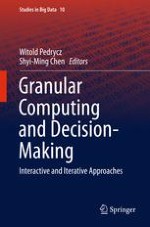2015 | OriginalPaper | Buchkapitel
Spatial-Taxon Information Granules as Used in Iterative Fuzzy-Decision-Making for Image Segmentation
verfasst von : Lauren Barghout
Erschienen in: Granular Computing and Decision-Making
Aktivieren Sie unsere intelligente Suche, um passende Fachinhalte oder Patente zu finden.
Wählen Sie Textabschnitte aus um mit Künstlicher Intelligenz passenden Patente zu finden. powered by
Markieren Sie Textabschnitte, um KI-gestützt weitere passende Inhalte zu finden. powered by
An image conveys multiple meanings depending on the viewing context and the level of granularity at which the viewer perceptually organizes the scene. In image processing, an image can be similarly organized by means of a standardized natural-scene-taxonomy, borrowed from the study of human visual taxometrics. Such a method yields a three-dimensional representation comprised of a hierarchy of nested spatial-taxons. Spatial-taxons are information granules composed of pixel regions that are stationed at abstraction levels within hierarchically-nested scene-architecture. They are similar to the Gestalt psychological designation of figure-ground, but are extended to include foreground, object groups, objects and salient object parts. By using user interaction to determine scene scale and taxonomy structure, image segmentation can be operationalized into a series of iterative two-class fuzzy inferences. Spatial-taxons are segmented from a natural image via a three step process. This chapter provides a gentle introduction to analogous human language and vision information-granules; and decision systems, modeled on fuzzy natural vision-based reasoning, that exploit techniques for measuring human consensus about spatial-taxon structure. A system based on natural vision-based reasoning is highly non-linear and dynamical. It arrives at an end-point spatial-taxon by adjusting to human input as it iterates. Human input determines the granularity of the query and consensus regarding spatial-taxon regions. The methods of concept algebra developed for computing with words [42] [48] are applied to spatial-taxons. Tools from the study of chaotic systems, such as tools for avoiding iteration problems, are explained in the context of fuzzy inference.
